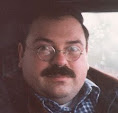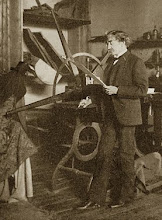
My hiatus from printing and printmaking seems to be at end and I’ve recently entered an intaglio exchange in order to insure that I have a specific goal in mind to bring me fully back into the swing of things. I work full-time and, being single, must take care of the many household and other tasks myself. I found the need to focus my limited spare time on my health, specifically with regard to physical exercise. Not being interested in sports, I turned to bicycle riding knowing that this would eventually tie in with printmaking as I could ride where I could not walk or drive to get subjects for the copper plate. I now have a restored bicycle and have started regular riding. At this time of the year my riding has been greatly curtailed but the way has been paved and the journey begun so now it’s back to the acid bath and the press.
I did manage to keep up my personal studies during this time, reading that I’ve found not only interesting in general but helpful in understanding the art that I’m attempting. This is especially true in the case of Whistler who I perhaps idealize more than I should but who, along with his contemporaries, is nonetheless a constant inspiration. Some of my most interesting reads have been Whistler’s letters. He is humorous, nonchalant, and deadly serious about his work all at the same time. He also has definite opinions on everything, especially etching. As an acknowledged master in several genres, that’s hardly surprising.
One of my favorite letters was that to Marcus Bourne Huish, an art dealer and member of the Fine Arts Society in London, concerning accusations that while in Venice in 1879/80 to carry out a paid commission from the Society he was instead rumored to have purchased large plates for work intended for others.
Below is part of his long but entertaining letter to reassure those concerned through his correspondent. Note how he refers to himself in the third person, an affectation not uncommon at that time in certain quarters. Whistler’s unofficial agent was Charles Augustus Howell who had heard the rumors about Whistler’s “large plates” and through concerned inquiries had thus spread them around. Huish heard the rumors and wrote to Whistler about them and this letter was Whistler’s response.
My dear Mr Huish -
I am shocked out of all my usual impassiveness by the suggestion I have this instant read with horror in your letter, that I could be neglecting the work, for which I had exiled myself, in order to trifle with plates, whose exaggerated size, not only partook of the character so generally accorded to all Howellian assertion, but would have been proof enough in itself - were any needed - of the unlikelihood of the story!
Little Mr Brown could have told you how Mr Whistler holds in contempt & derision the "big plate" - the advertisement of the ignorant - the inevitable pitfall of the amateur -
I am even astonished that Howell himself - in his desire to make statements - should have missed this tip - as he has often heard me scoff at the vulgarity of the pretence - and point out the gross condition of brain that could tolerate the offensive disproportion between the delicate needle of the etcher and the monster plate to be covered! - Perceive how inartistic is the undertaking - based as it is on the dulness which distinguishes not between mastery of manner, and "muchness" of matter! - From this pente ridicule the painter's science saves him - he knows that the dimensions of work must be always in relation to the means used - and reaching the limit, unerringly lays aside the needle for the brush, that he may not find himself worming his weary way across a waste of copper - all quality lost - all joy of execution gone - nothing remaining but the doleful task for the dreary industry of the foolish - the virtue of the duffer!. - Behold now the hardy though unconscious Amateur! - He hesitates not! - and so we have heads the size of soup plates - and landscapes like luncheon trays - while lines are bitten furiously until in the impression they stand out like the knotted veins on his own unthinking brow –
Poor meek Rembrant! - with his mild miniatures - beside such colossal deeds how dwarfed he becomes! how uninteresting his puny portraits of diminutive BurgomasterSiegmund Clement de Young - how weak his little windmill - - - - - - Ah well! nous avons changé tout celà (we have changed all that).
Without taking sides, I can at least say that as usual, there’s nothing new under the sun and things seem to have come full circle once again. I admit to being astonished at the size of some of the plates I’ve seen though in those cases the use of the needle seems to have bee replaced almost entirely for wider tools that sometimes seem to amount to spatulas. Needling the plate hardly seems a proper description. I offer no criticism one-way or the other. I’m a mere amateur myself and not a particularly skilled one.
But I do find it interesting from an historical, technical, and stylistic perspective. Some styles change and some remain but there does seem to be a constant, common thread that weaves its way through all of them. In one way or another I think we each develop our own personal method of expression, for better or worse. Studying these subjects has helped me focus better on what I’m trying to achieve. Hopefully it will have the same affect on you.



+With+Press+cropped.jpg)



No comments:
Post a Comment